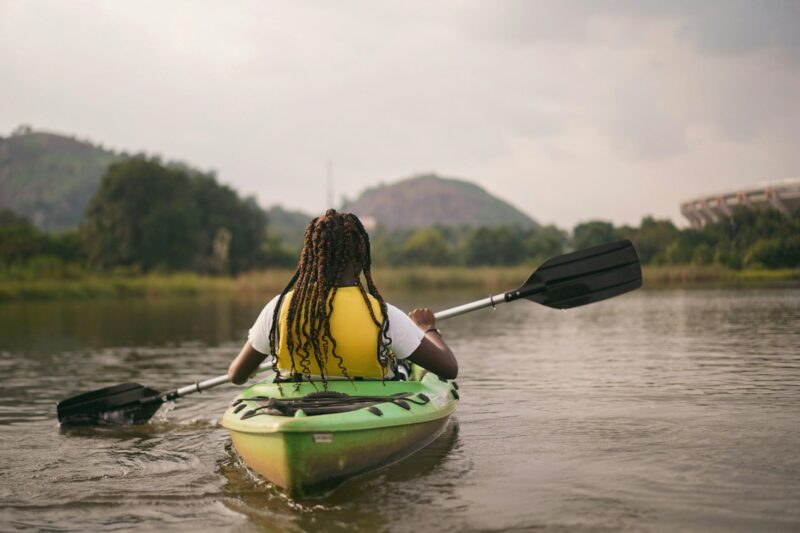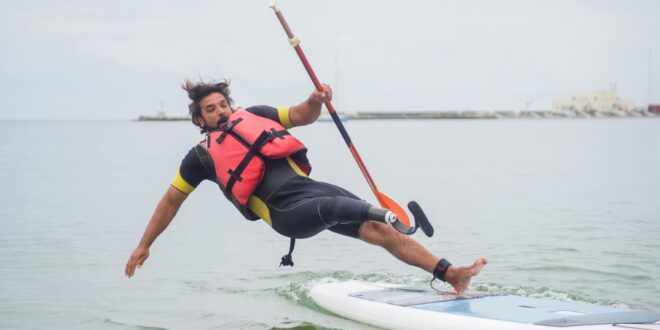Stay Afloat: Your Lifeline on the Water.
Introduction:
Stay Afloat: The Importance and Functionality of Life Jackets for Water Safety
Life jackets are a crucial piece of equipment for anyone participating in water activities. Whether you are swimming, boating, or engaging in water sports, wearing a life jacket can mean the difference between life and death in the event of an accident. In this article, we will explore the importance of life jackets for water safety and discuss their functionality in keeping individuals afloat in emergency situations.
The History of Life Jackets
Life jackets, also known as personal flotation devices (PFDs), are an essential piece of equipment for anyone spending time on the water. These simple yet effective devices have been saving lives for centuries, making them a crucial tool for water safety. Let’s take a closer look at the history of life jackets and how they have evolved over time.
The concept of a life jacket dates back to ancient times when people used inflated animal skins or hollow gourds to help them stay afloat in the water. These early versions were rudimentary but served the same purpose as modern-day life jackets – to keep the wearer buoyant and prevent drowning.
As technology advanced, so did the design of life jackets. In the 19th century, cork became a popular material for life jackets, providing better buoyancy and comfort for the wearer. These cork life jackets were often bulky and uncomfortable, but they were a significant improvement over previous designs.
In the early 20th century, kapok became the material of choice for life jackets. Kapok is a lightweight, buoyant fiber that provided excellent flotation without the bulk of cork. This innovation made life jackets more comfortable and easier to wear, increasing their effectiveness in saving lives.
During World War II, the inflatable life jacket was introduced, revolutionizing the design of life jackets. These inflatable PFDs were compact and lightweight, making them easy to wear and store. They were also more adjustable, allowing for a better fit and increased comfort for the wearer.
Today, life jackets come in a variety of styles and designs to suit different water activities and personal preferences. From traditional foam-filled jackets to inflatable PFDs, there is a life jacket for everyone. Whether you’re boating, fishing, kayaking, or participating in water sports, wearing a life jacket is essential for your safety.
The functionality of a life jacket is simple yet crucial. When worn correctly, a life jacket helps keep your head above water, even if you are unconscious. This is especially important in situations where you may fall overboard or become injured while in the water. A life jacket can provide the extra time needed for rescue teams to reach you and bring you to safety.
In addition to keeping you afloat, a life jacket also helps conserve your energy. In cold water, wearing a life jacket can prevent hypothermia by keeping your body out of the water and retaining body heat. This can be a lifesaving feature in emergency situations where help may not arrive immediately.
It’s important to remember that wearing a life jacket is not just for your safety but for the safety of those around you. Accidents can happen quickly on the water, and having a life jacket on can make all the difference in a life-threatening situation. By setting a good example and wearing your life jacket, you encourage others to do the same and promote a culture of water safety.
In conclusion, life jackets have come a long way since their humble beginnings, evolving into essential tools for water safety. Whether you’re a seasoned boater or a casual swimmer, wearing a life jacket is a simple yet effective way to protect yourself and those around you. So remember, stay afloat and stay safe – wear your life jacket every time you’re on the water.
Different Types of Life Jackets
When it comes to water safety, one of the most important pieces of equipment you can have is a life jacket. Whether you’re out on a boat, paddleboarding, or just enjoying a day at the beach, having a properly fitted life jacket can mean the difference between life and death in an emergency situation. But with so many different types of life jackets on the market, how do you know which one is right for you? In this article, we’ll explore the different types of life jackets available and help you choose the best one for your needs.
One of the most common types of life jackets is the Type I offshore life jacket. These jackets are designed for use in rough waters and are typically the most buoyant type of life jacket available. They are often used on commercial vessels and are required by law to be on board any boat that is operating more than three miles from shore. Type I life jackets are designed to turn an unconscious person face-up in the water, making them ideal for use in emergency situations.
Another popular type of life jacket is the Type II near-shore buoyant vest. These jackets are less bulky than Type I jackets and are designed for use in calm, inland waters where rescue is likely to be quick. Type II life jackets are often used for recreational boating and are a good choice for children and inexperienced swimmers. While they may not be as buoyant as Type I jackets, they still provide enough flotation to keep you afloat in an emergency.
For those who enjoy water sports like kayaking or paddleboarding, a Type III flotation aid may be the best option. These jackets are designed for use in calm waters where rescue is quick and are often more comfortable to wear for extended periods of time. Type III life jackets are available in a variety of styles, including inflatable vests and belt packs, making them a popular choice for active water enthusiasts.
If you’re looking for a life jacket that offers maximum mobility and comfort, a Type V special-use device may be the best option for you. These jackets are designed for specific activities like waterskiing, windsurfing, or fishing and are often more lightweight and less bulky than other types of life jackets. Type V life jackets are available in a variety of styles, including inflatable vests and hybrid designs, making them a versatile choice for a wide range of water activities.
No matter which type of life jacket you choose, it’s important to make sure that it fits properly and is in good condition before heading out on the water. A properly fitted life jacket should be snug but not restrictive, with all straps and buckles securely fastened. It’s also important to regularly inspect your life jacket for any signs of wear or damage and replace it if necessary.
In conclusion, having the right type of life jacket can make all the difference when it comes to water safety. Whether you’re out on a boat, paddleboarding, or just enjoying a day at the beach, having a properly fitted life jacket can give you peace of mind knowing that you’re prepared for any emergency situation. So before you head out on the water, make sure you have the right type of life jacket for your needs and stay safe out there!
Importance of Wearing a Life Jacket
Are you someone who loves spending time on the water? Whether you enjoy boating, kayaking, paddleboarding, or any other water activity, it’s important to prioritize safety. One essential piece of safety equipment that should never be overlooked is a life jacket.
Life jackets, also known as personal flotation devices (PFDs), are designed to keep you afloat in the water in case of an emergency. They come in various styles and sizes to fit different body types and activities. While some people may think that wearing a life jacket is unnecessary or uncool, the reality is that they can save lives.
One of the most important reasons to wear a life jacket is that it can prevent drowning. Accidents can happen on the water, whether it’s due to rough waves, strong currents, or a sudden fall overboard. In these situations, a life jacket can provide the buoyancy needed to keep your head above water and allow you to breathe until help arrives.
Another reason to wear a life jacket is that it can provide insulation in cold water. If you find yourself in chilly waters, a life jacket can help retain body heat and prevent hypothermia. This is especially important for boaters and paddlers who may be exposed to the elements for an extended period of time.
Life jackets are also essential for children and inexperienced swimmers. Kids can easily get into trouble in the water, and having them wear a properly fitted life jacket can give you peace of mind knowing that they are safe. Similarly, if you are not a strong swimmer or are new to water activities, wearing a life jacket can give you the confidence to enjoy your time on the water without fear.
It’s important to remember that accidents can happen to anyone, regardless of their swimming abilities or experience level. Even the most skilled swimmers can find themselves in dangerous situations on the water. By wearing a life jacket, you are taking a proactive step to protect yourself and those around you.
In addition to the safety benefits, wearing a life jacket is also required by law in many places. Boaters, kayakers, and paddleboarders are often required to have a Coast Guard-approved life jacket on board for each person. Failing to comply with these regulations can result in fines or other penalties.
When choosing a life jacket, it’s important to select one that fits properly and is appropriate for your activity. There are different types of life jackets, including inflatable, foam, and hybrid styles. Make sure to read the manufacturer’s instructions and guidelines for proper use and maintenance.
In conclusion, wearing a life jacket is a simple yet crucial step to staying safe on the water. Whether you’re a seasoned boater or a beginner paddler, having a life jacket can make all the difference in an emergency. So next time you head out on the water, don’t forget to grab your life jacket and stay afloat. Your safety is worth it.
How Life Jackets Work
When it comes to water safety, one of the most important pieces of equipment you can have is a life jacket. Whether you’re out on a boat, paddleboarding, or just enjoying a day at the beach, having a properly fitted life jacket can mean the difference between life and death in an emergency situation.
Life jackets work by providing buoyancy to help keep you afloat in the water. They are designed to keep your head above water and prevent you from sinking. This is crucial in situations where you may be injured, unconscious, or simply unable to swim. By wearing a life jacket, you can increase your chances of survival in the event of an accident.
There are different types of life jackets available, each designed for specific activities and water conditions. For example, a Type I life jacket is designed for offshore use and is the most buoyant type available. Type II life jackets are intended for near-shore use and are less bulky than Type I jackets. Type III life jackets are commonly used for water sports like kayaking and paddleboarding, as they are more comfortable and allow for greater freedom of movement.
Regardless of the type of life jacket you choose, it is important to ensure that it fits properly. A properly fitted life jacket should be snug but not too tight, with all straps and buckles securely fastened. It should also be the appropriate size for your weight and chest size. If a life jacket is too big or too small, it may not provide adequate buoyancy in an emergency.
In addition to proper fit, it is important to regularly inspect your life jacket for any signs of wear or damage. Check for tears, fraying, or broken buckles, and replace your life jacket if it shows any signs of deterioration. It is also a good idea to practice putting on your life jacket and getting in the water with it on, so you are familiar with how it feels and performs.
One of the key functions of a life jacket is to keep your head above water in the event of an emergency. This is especially important if you are unconscious or unable to swim. By wearing a life jacket, you can reduce the risk of drowning and increase your chances of being rescued. In addition to providing buoyancy, life jackets are also designed to be highly visible in the water, making it easier for rescuers to spot you in an emergency.
In conclusion, life jackets are a crucial piece of equipment for water safety. They work by providing buoyancy to help keep you afloat in the water and can mean the difference between life and death in an emergency situation. By choosing the right type of life jacket, ensuring a proper fit, and regularly inspecting your equipment, you can stay safe and enjoy your time on the water with peace of mind. Stay afloat and stay safe with a reliable life jacket by your side.
Life Jacket Regulations and Standards

When it comes to water safety, one of the most important pieces of equipment you can have is a life jacket. Whether you’re out on a boat, paddleboarding, or just enjoying a day at the beach, wearing a life jacket can make all the difference in an emergency situation. But not all life jackets are created equal, and it’s important to understand the regulations and standards that govern their design and use.
In the United States, the U.S. Coast Guard is responsible for setting regulations and standards for life jackets. These regulations are designed to ensure that life jackets are effective in keeping people safe in the water. One of the most important regulations is that all boats must have a U.S. Coast Guard-approved life jacket for each person on board. This means that the life jacket has been tested and meets specific safety standards.
There are several different types of life jackets that are approved by the U.S. Coast Guard. Type I life jackets are designed for offshore use and are the most buoyant, providing the most flotation. Type II life jackets are intended for near-shore use and are less bulky than Type I jackets. Type III life jackets are designed for calm, inland waters and are the most comfortable to wear for extended periods of time. Type IV devices, such as throwable cushions or rings, are not worn but are designed to be thrown to someone in the water. Type V life jackets are specialized devices that are designed for specific activities, such as kayaking or waterskiing.
It’s important to choose the right type of life jacket for the activity you’ll be doing. For example, if you’re going kayaking, you’ll want a Type III or Type V life jacket that allows for freedom of movement. If you’re going boating offshore, you’ll want a Type I life jacket that provides maximum flotation. It’s also important to make sure that the life jacket fits properly and is in good condition. A life jacket that is too big or too small won’t be effective in keeping you safe in the water.
In addition to the type of life jacket, there are also regulations regarding when and where you should wear a life jacket. In most states, children under a certain age are required to wear a life jacket while on a boat. Some states also require that anyone participating in certain water activities, such as waterskiing or tubing, wear a life jacket. It’s always a good idea to check the regulations in your state to make sure you’re in compliance.
Overall, life jackets play a crucial role in keeping people safe in the water. By understanding the regulations and standards that govern their design and use, you can make sure that you’re properly equipped for any water activity. So next time you’re out on the water, remember to stay afloat and wear your life jacket!
Life Jackets for Different Water Activities
When it comes to water safety, one of the most important pieces of equipment you can have is a life jacket. Whether you’re out on a boat, paddleboarding, or even just swimming in a lake, having a life jacket can mean the difference between life and death in an emergency situation. In this article, we’ll explore the importance and functionality of life jackets for different water activities.
For boating enthusiasts, wearing a life jacket is not only a smart choice but also a legal requirement in many places. Boating accidents can happen in an instant, and having a life jacket on can keep you afloat until help arrives. There are different types of life jackets designed specifically for boating, with features like reflective tape and whistles to help rescuers locate you in the water. It’s important to choose a life jacket that fits properly and is approved by the Coast Guard to ensure maximum safety on the water.
For those who enjoy paddleboarding or kayaking, wearing a life jacket is just as crucial. Even if you’re a strong swimmer, unexpected currents or weather conditions can quickly turn a fun outing into a dangerous situation. A life jacket can provide buoyancy and keep you afloat if you fall off your board or kayak. Look for a life jacket that is comfortable to wear while paddling and allows for freedom of movement. Many paddleboarders opt for inflatable life jackets that can be worn around the waist and inflated manually in an emergency.
Swimming in open water, such as a lake or river, also poses risks that can be mitigated by wearing a life jacket. Even experienced swimmers can tire quickly in rough water or strong currents, making it difficult to stay afloat. A life jacket can provide the extra buoyancy needed to keep your head above water until help arrives. Look for a life jacket that is designed for swimming and allows for easy movement in the water. Bright colors and reflective tape can also help make you more visible to rescuers in an emergency.
No matter what water activity you enjoy, wearing a life jacket is a simple and effective way to stay safe on the water. In addition to choosing the right type of life jacket for your activity, it’s important to ensure that it fits properly and is in good condition. Check your life jacket regularly for signs of wear and tear, and replace it if necessary to ensure maximum safety.
In conclusion, life jackets are an essential piece of equipment for anyone who spends time on or near the water. Whether you’re boating, paddleboarding, or swimming, wearing a life jacket can save your life in an emergency. By choosing the right type of life jacket for your activity and ensuring that it fits properly, you can enjoy your time on the water with peace of mind knowing that you’re prepared for any situation. Stay afloat and stay safe with a life jacket!
Benefits of Using a Life Jacket
When it comes to water safety, one of the most important pieces of equipment you can have is a life jacket. Whether you’re out on a boat, paddleboarding, or simply swimming in a lake or pool, wearing a life jacket can make all the difference in an emergency situation. In this article, we’ll explore the benefits of using a life jacket and why it’s essential to stay afloat in the water.
First and foremost, wearing a life jacket can save your life. In the event of an accident or unexpected fall into the water, a life jacket can keep you buoyant and prevent you from drowning. Even the strongest swimmers can find themselves in trouble when faced with rough waters or unexpected currents. Having a life jacket on can give you the extra support you need to stay afloat until help arrives.
Not only does a life jacket provide buoyancy, but it also offers added protection in case of injury. If you hit your head or become unconscious while in the water, a life jacket can keep your head above the surface and prevent you from inhaling water. This added layer of protection can be crucial in preventing serious injury or even death.
Another benefit of using a life jacket is that it can provide peace of mind for both you and your loved ones. Knowing that you have a safety device on hand can help alleviate any fears or anxieties you may have about being in the water. This can make your time spent on the water more enjoyable and relaxing, allowing you to focus on having fun and making memories with friends and family.
Life jackets are also designed to be comfortable and easy to wear. With adjustable straps and lightweight materials, modern life jackets are more comfortable than ever before. This means you can wear your life jacket for extended periods without feeling restricted or uncomfortable. Some life jackets are even designed to be worn over clothing, making them easy to put on and take off as needed.
In addition to providing safety and comfort, life jackets are also required by law in many water activities. Whether you’re boating, kayaking, or participating in water sports, wearing a life jacket is often a legal requirement. Failing to wear a life jacket can result in fines or penalties, so it’s important to always have one on hand when you’re on the water.
Overall, the benefits of using a life jacket are clear. From providing buoyancy and protection to offering peace of mind and comfort, a life jacket is an essential piece of equipment for anyone spending time on the water. By wearing a life jacket, you can stay afloat in the water and ensure your safety in any situation. So next time you head out on the water, don’t forget to grab your life jacket and stay safe!
Proper Care and Maintenance of Life Jackets
Life jackets are an essential piece of equipment for anyone who spends time on or near the water. Whether you’re boating, fishing, kayaking, or participating in any other water activity, wearing a life jacket can mean the difference between life and death in an emergency situation. However, simply owning a life jacket is not enough – proper care and maintenance are crucial to ensure that your life jacket will function properly when you need it most.
One of the most important aspects of caring for your life jacket is to regularly inspect it for any signs of wear or damage. Check the seams, straps, and buckles for any fraying or tears, and make sure that all components are in good working order. If you notice any issues, it’s important to repair or replace the life jacket immediately to ensure that it will provide the necessary buoyancy in an emergency.
In addition to regular inspections, it’s also important to clean your life jacket regularly to remove any dirt, salt, or other debris that can accumulate over time. Most life jackets can be hand-washed with mild soap and water, but be sure to check the manufacturer’s instructions for specific cleaning recommendations. Avoid using harsh chemicals or abrasive cleaners, as these can damage the fabric and reduce the effectiveness of the life jacket.
Proper storage is another key aspect of life jacket maintenance. When not in use, store your life jacket in a cool, dry place away from direct sunlight and extreme temperatures. Avoid folding or compressing the life jacket, as this can damage the foam and reduce its buoyancy. Instead, hang the life jacket on a sturdy hanger or lay it flat to ensure that it retains its shape and functionality.
It’s also important to regularly test your life jacket to ensure that it will provide the necessary buoyancy in an emergency. Most life jackets are designed to keep your head above water, but it’s important to make sure that yours fits properly and is adjusted correctly. To test your life jacket, put it on and jump into shallow water to see how it performs. If you have any concerns about the fit or buoyancy of your life jacket, consider investing in a new one that meets your needs and provides the necessary level of safety.
By taking the time to properly care for and maintain your life jacket, you can ensure that it will function properly when you need it most. Regular inspections, cleaning, storage, and testing are all essential aspects of life jacket maintenance that can help keep you safe on the water. Remember, a life jacket is not just a piece of equipment – it’s a potentially life-saving device that can make all the difference in an emergency. So stay afloat and stay safe by taking care of your life jacket and ensuring that it’s always ready to protect you in any situation.
Life Jackets as Essential Water Safety Equipment
When it comes to water safety, one of the most important pieces of equipment you can have is a life jacket. Whether you’re out on a boat, paddleboarding, or simply swimming in a lake or pool, wearing a life jacket can mean the difference between life and death in an emergency situation. In this article, we’ll explore the importance and functionality of life jackets for water safety, and why you should always make sure to wear one whenever you’re in or around the water.
Life jackets are designed to keep you afloat in the water, even if you’re unconscious or unable to swim. They are typically made of buoyant materials that help to keep your head above water and prevent you from sinking. This is especially important in situations where you may be injured or unable to swim due to fatigue or other factors. By wearing a life jacket, you can greatly increase your chances of survival in the event of an accident or emergency.
One of the key functions of a life jacket is to provide buoyancy and support in the water. This is achieved through the use of materials such as foam or inflatable chambers that help to keep you afloat. Life jackets are also designed to be adjustable, so you can ensure a snug and secure fit that won’t slip off in the water. This is important for preventing the jacket from coming off in rough waters or during a fall, which could leave you vulnerable and at risk of drowning.
Another important function of life jackets is to provide visibility in the water. Many life jackets are brightly colored or have reflective strips that make it easier for rescuers to spot you in the water. This can be crucial in situations where you may be lost or stranded, as it can help to expedite the rescue process and ensure that you are found quickly. By wearing a brightly colored or reflective life jacket, you can make yourself more visible and increase your chances of being rescued in a timely manner.
In addition to providing buoyancy and visibility, life jackets also offer protection from the elements. In cold water, a life jacket can help to insulate your body and prevent hypothermia. It can also provide some protection from the sun’s harmful rays, especially if it has a built-in sun protection factor (SPF). By wearing a life jacket, you can stay safe and comfortable in the water, no matter what the conditions may be.
Overall, life jackets are an essential piece of equipment for anyone who spends time in or around the water. They provide buoyancy, support, visibility, and protection, all of which are crucial for staying safe in the water. Whether you’re a seasoned swimmer or a novice paddler, wearing a life jacket can help to ensure that you stay afloat and out of harm’s way in any water-related situation. So remember, always wear your life jacket and stay safe on the water!
Conclusion
Life jackets are essential for water safety as they help individuals stay afloat in the water. They provide buoyancy and support, reducing the risk of drowning in case of accidents or emergencies. It is important for everyone, especially non-swimmers and children, to wear a life jacket while in or around water to prevent accidents and ensure their safety. In conclusion, life jackets play a crucial role in water safety by keeping individuals afloat and should be worn at all times to prevent accidents and potential drowning incidents.
 Wnkrs Blog Celebrating Every Style and Space
Wnkrs Blog Celebrating Every Style and Space





